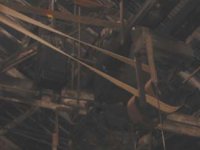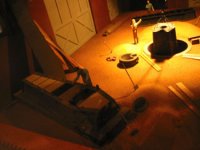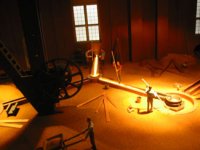Selma Hunter
Established Users
Belt Drive Opportunity for You
All -
I'm adding a series of pics for the drive system in one of the 1893 machine shop on the site of the old Foundry. FWIW, the preservation society leader for this site is almost desperate for help to preserve the site - it can still be lost due to local political disinterest - not to say outright political animosity. There are numerous old machines in the building(s) including a large drop hammer, small lathe or facing machine, furnaces, etc. More pics later. He could sure use some help - they get together every other Saturday to work on the building and grounds.
The first two pics are the belt drop to a grinding station and the grinding station itself, the last two are the extended feed from the primary shaft over the shop main floor. The work station is in a separate room - note the old pass-though in the brick wall near the "new" motor on the wall. The electrics in here are museum vintage. Building is circa 1893, but similar to CW tooling in all respects.
Anybody know anybody with any influence in terms of designating sites of historical significance please say so.
Thanks for your interest in all this.
Enjoy.
All -
I'm adding a series of pics for the drive system in one of the 1893 machine shop on the site of the old Foundry. FWIW, the preservation society leader for this site is almost desperate for help to preserve the site - it can still be lost due to local political disinterest - not to say outright political animosity. There are numerous old machines in the building(s) including a large drop hammer, small lathe or facing machine, furnaces, etc. More pics later. He could sure use some help - they get together every other Saturday to work on the building and grounds.
The first two pics are the belt drop to a grinding station and the grinding station itself, the last two are the extended feed from the primary shaft over the shop main floor. The work station is in a separate room - note the old pass-though in the brick wall near the "new" motor on the wall. The electrics in here are museum vintage. Building is circa 1893, but similar to CW tooling in all respects.
Anybody know anybody with any influence in terms of designating sites of historical significance please say so.
Thanks for your interest in all this.
Enjoy.








